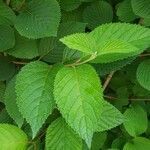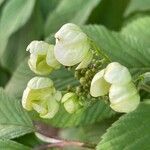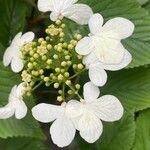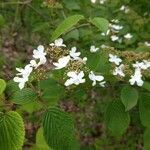Shrubs, deciduous, to 3 m tall. Bark light brown. Branchlets of current year densely or sparsely yellowish brown stellate-pubescent; branchlets of previous year gray-brownish or gray-blackish, terete, sparsely pubescent or subglabrous, with dispersed, small, rounded lenticels. Winter buds lanceolate-triangular, with a pair of adnate scales; scales sparsely yellowish brown stellate-pubescent. Leaves always opposite, not clustered at apices of branchlets; stipules absent; petiole green, robust, 1-2 cm, thinly stellate-pubescent; leaf blade green when young, broadly ovate, orbicular-obovate, or obovate, rarely suborbicular, 4-12 × (2-)3-7 cm, papery, abaxially densely tomentose or sometimes only hairy on lateral veins, adaxially sparsely adpressed pubescent, more densely so on midvein, midvein raised abaxially, lateral veins 6-12(-17)-jugate, pinnate, slightly arched, branched, ending in teeth, conspicuously raised abaxially, often deeply impressed adaxially, veinlets transverse, slightly raised abaxially, slightly impressed adaxially, not lobed, base rounded or broadly cuneate, very slightly cordate, without glands, margin irregularly serrate, apex rounded or abruptly narrowed and slightly mucronate. Flowers appearing after leaves; inflorescence a compound umbel-like cyme, globose or flattened, at apices of short lateral branchlets with 1 pair of leaves, 5-10 cm in diam.; rays whorled; first node of inflorescence with 3-8 rays, dense, minutely or densely yellowish brown stellate-pubescent, totally composed of large sterile flowers, or of fertile flowers yet with 6-8 large sterile radiant flowers; peduncles 1.5-4 cm; bracts caducous, leaflike, green, lanceolate, 1.5-6 mm, sparsely hairy; bracteoles scalelike. Flowers on rays of 4th order, not fragrant, sessile or shortly pedicellate. Sterile flowers: calyx like fertile flowers; corolla white, rotate, 1.5-4 cm in diam.; lobes obovate or suborbicular, sometimes only 4, often unequal in size with 1 very small lobe, apex rounded; stamens and pistils not developed. Fertile flowers: calyx green or reddish; tube obconical, ca. 1.5 mm, glabrous or stellate-hairy; lobes triangular, ca. 0.5 mm, glabrous, apex ± acute; corolla yellow-white, rotate, 2-3 mm in diam., glabrous; tube 1-1.5 mm; lobes spreading or slightly recurved, broadly ovate, ca. as long as wide, apex rounded, margin entire; stamens exceeding corolla, inserted near base of corolla; filaments 3-4.5 mm; anthers yellow, oblong or suborbicular, ca. 1 mm; styles slightly exceeding calyx lobes; stigmas 3-lobed. Fruit initially turning red, maturing black, broadly ovoid-orbicular or obovoid-orbicular, 5-6.5 × 3-4 mm, base rounded, apex rounded, glabrous; pyrenes compressed, ellipsoid, 4-5.5 × 2.5-3 mm, with a broad ventral groove, both ends obtuse. Fl. Apr-May, fr. Aug-Sep. 2n = 18, 72.
More
A shrub. It grows 2.5-3.7 m tall and spreading 3-4.5 m wide. The branches are horizontal. It loses its leaves during the year. The leaves appear to be pleated. The leaves are opposite and broadly oval. They are 4-12 cm long by 3-7 cm wide. The flowers occur in heads. They are yellow to white. The fruit is oval and red but turn black as they ripen. They are 5-7 mm long by 3-4 mm wide.




